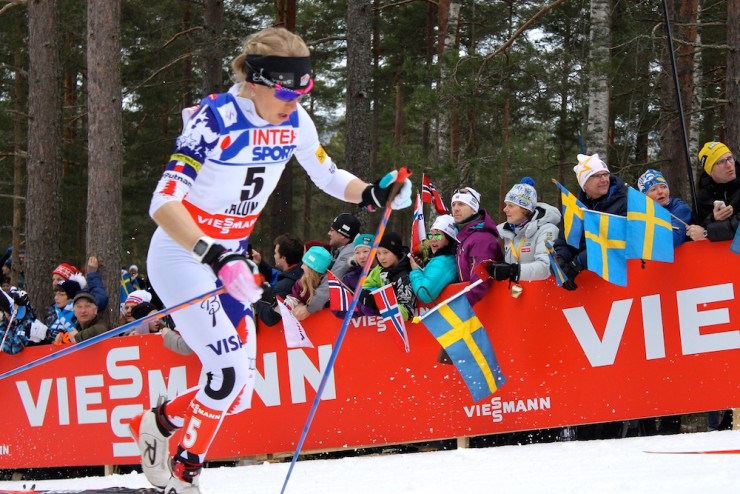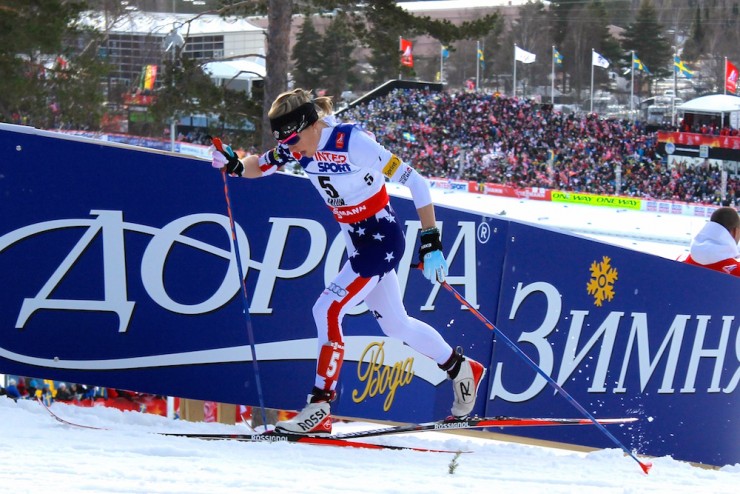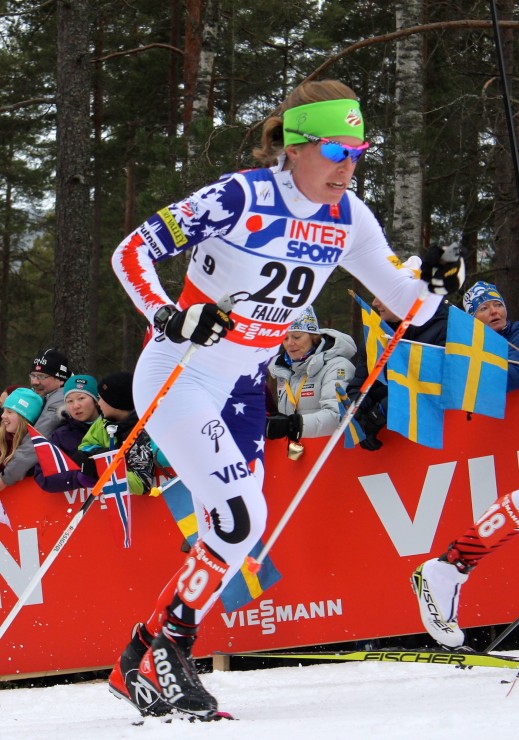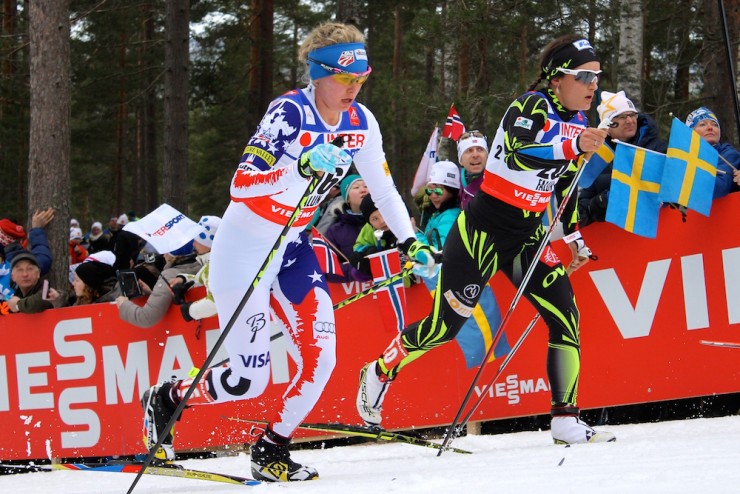
FasterSkier’s coverage of the 2015 FIS Nordic World Ski Championships in Falun, Sweden, is brought to you by the generous support of L.L. Bean, now featuring a complete line of Kikkan Randall training wear.
FALUN, Sweden — Everyone knows the U.S. women are strong skaters. It’s been proven again and again by the World Cup sprint globes, World Championships medals, and Tour de Ski final climbs. So when all three U.S. finishers place in the top-20 in the most anticipated 30 k mass start of the year, it was safe to assume no classic skiing was involved.
Wrong.
In Saturday’s 3o k classic mass start at the 2015 FIS Nordic World Ski Championships the U.S. proved it could mix things up in classic distance racing, as Liz Stephen, Rosie Brennan, and Sadie Bjornsen skied away to 11th, 16th, and 20th place finishes. They followed dominant performance by Norway’s Therese Johaug, who was victorious with a time of 1:24:47.0.
Things started off with the U.S. in the spotlight. Stephen, starting in row one, had what she characterized as an unusually good start – striding alongside Marit Bjørgen and Heidi Weng of Norway. Stephen later slipped to 24th as teammate Bjornsen rose through the ranks from bib 15 to lead the race.
“There was one point at 5 k where I was leading the race,” Bjornsen laughed. “Like, this is fun, but….”
By the time Johaug made a break for the lead at roughly seven kilometers into the race, the Americans were out of the lead pack. What they lacked in position, however, they made up for in teamwork as they skied with other chasers to stay in the race – Brennan was in 13th while Stephen climbed back into 14th place followed by Bjornsen in 17th.

“In general I work my way into races probably more than most,” Stephen said. “I knew that people were going to come back to me, maybe not everybody, but certainly people. I was just fighting with a group that I was with to kind of move us all up. When we changed skis, I was really happy to change skis as they were noticeably faster.”
As the race continued women began to drop from the pack that contained Stephen and Brennan. Stephen charged and after several more times up the Falun courses’ punishing climbs, she skied her way into tenth place.
While the much of the course remained firm, the snow on each climb was turning to slush. Some teams struggled to find kick, as skiers like third place finisher Charlotte Kalla of Sweden and Aino-Kaisa Saarinen of Finland were forced to herringbone up the Mörderbacken climb. The Americans’ skis were good, however, and Stephen thrived in the slow snow.
“I was praying that they weren’t going to salt today because a icy classic course is not what I want,” Stephen explained. “It was getting slushy in places but it held together really well. I’d always rather have slow conditions than fast.”
Stephen’s steady pace caught Teresa Stadlober of Austria and dropped Norway’s Martine Ek Hagen, who had been tight on her ski tails at 25 k. At the same time, Ingvild Flugstad Østberg also of Norway, managed to catch up after a slow start that had left her over 30 seconds behind Stephen.

The two came into the finishing straight together but Østberg, who won team sprint gold earlier in the Championships as well as two individual World Cup sprints this season, had more speed at the end.
“I was hoping for a top-10,” Stephen said. “11th is pretty close and to be out-sprinted by Ingvild I think is ok. The strategy was to try and have a good start which I did, and to just ski the best classic I could – relax and keep the technique together because that’s when I go the fastest.”
Despite missing the top-10 the race was one of the top classic races of Stephen’s career. This season she had a breakthrough at the Tour de Ski, finishing fifth in a 10 k classic mass start in Val di Fiemme, Italy. Before that, she had finished sixth in another 10 k classic in Poland.
Stephen placed 16th in the same event at 2013 World Championships in Val di Fiemme, and also 16th in the 30 k freestyle at 2011 World Championships in Oslo, Norway. No American woman has placed in the top 10 of a World Championships 30 k since the event debuted in 1989 (before that, when the men competed in a 50 k, the women skied only 20 k, or before 1982, they simply did not compete in long distances at all).

Two More Top-20
Halfway through, Brennan and Bjornsen were in a group fighting for 15th place.
“I knew that it was going to go out hard, so I thought, I’m going to fight with everything I have for 10 k, and then hope they slow down a little bit and I find a group to ski with,” Brennan explained. “It worked out pretty well, I got a nice little to work with for most of the race.”
Bjornsen was also hoping to hold onto the leaders as long as she could.
“I haven’t been feeling on fire lately, so I just wanted to fight as long as I could and then see what happens,” Bjornsen said. “That’s the way 30 k’s work. Or at least that’s how I have raced 30 k’s in the last couple of years, is to just hold on as long as possible and some days you can, some days you can’t. Today I definitely struggled right around 10 or 15 k.”
But while Bjornsen was unable to stay with the pack, her Alaska Pacific University teammate Brennan just kept on going.
“I knew I was in a good group that was going to mean a good result, and that maybe if we kept charging we’d catch some stragglers from the front group,” she said. “So I just tried to hang on and keep going.”
In the 5 k she was passed by a few skiers – Østberg and Seraina Boner of Switzerland – and caught by Justyna Kowalczyk of Poland. When Kowalczyk went past Brennan, the American fell behind by roughly 16 seconds at the 27 k mark.
“I was really bummed that I couldn’t catch her in the relay,” she said of the two-time Olympic gold medalist. “So when she passed me I was like, ‘now’s my chance! I can get her back.’ I have really bad downhill skills, but she’s also not exactly known for her downhill skiing. So I was like, this is the perfect person to come into the stadium with. I’ll just go for it!”
And go for it she did.
Determined to make up that ground she lost, Brennan demolished the time difference between her and Kowalczyk. Less than a kilometer from the finish, the two were once again skiing together. As the two climbed to short stadium hill, Brennan pulled ahead of the Polish skier to to take the lead into the final meters. She double-poled furiously to stay ahead, out-sprinting Kowalczyk to the line by one tenth of a second.
“You don’t have to tell Rosie to catch somebody. She’s on it,” U.S. Ski Team women’s coach Matt Whitcomb said after Brennan’s finish. “We started giving splits from Kowalczyk to Rosie with about 2 k to go. We figured that with 16 seconds back it could be done.”

Just over a minute later, Bjornsen crossed the line in 20th place.
“It wasn’t the most spectacular race, but I’m certainly happy to have a sub-par race and be in the 20’s,” Bjornsen said. “I’m happy. It was fun. A great way to end the Championships, to spend an hour and a half skiing in that crowd and going through the pain train, and then recovering, and then more pain train.”
Bjornsen, too had a finishing battle, in her case with Anne Kyllönen of Finland.
“The only thing that was keeping me going at the end is that I was skiing next to one of the Finnish girls who I sprint with, and I was like, okay, I know I can be stronger than her – even if I don’t really know if I’m stronger than her!” Bjornsen laughed. “But at least I know how she skis, and I’m going to decide that I’m actually stronger than her right now.”
It was Bjornsen’s third result in a row in roughly the same position: she finished 20th in the 15 k skiathlon and 19th in the classic sprint. While she’s relieved to have consistent performances on days that she doesn’t feel her best, she also said that it can be hard to have consistently good, but not standout, results.
“I guess consistency is the answer this year,” Bjornsen said. “It’s hard to be patient because last year I had some races that were way high, and some that were way low, and this year it’s more stable. It’s sometimes hard.”
Brennan, who is in an earlier stage of her international career despite being a many-time teammate of Bjornsen’s at World Junior Championships and Under-23 World Championships, feels different: she’s having breakthrough results after coming to Europe as the Continental Cup leader in mid-January.
“If you had asked me at the beginning of the year, no way,” she said when asked whether she had expected to leave World Championships with this caliber of results. “Not a chance. After I came over here and started having a few good results, I was hoping that I could find some sort of peak here and have some good results. So I’m really happy with how it went. I wish I could have raced more races, but it was my first time, so I have to earn my way onto all the starts.”
“The only way I was going to finish the race was if I was having a really good day”
Jessie Diggins was the fourth American starter in Saturday’s 30 k, but entered with a different mentality than her fellow teammates. After talking with her personal coach, USST assistant Jason Cork, the two decided that the only way Diggins would finish the 30 k was if race was going well.
“I came up with a plan with my coach to start and the only way I was going to finish the race was if I was having a really, really good day,” Diggins explained.

The Minnesota native began the race as the sixteenth ranked skier and held her position for much of the first kilometers. At the 3.3. k mark she was skiing 11 seconds behind Bjørgen and Johaug and by the time she reached the top of Mördarbacken she was in contact with the large group of leaders.
The deciding factor of Diggins’ race took place soon after. According to the 23-year-old an unidentified skier changed lanes in front of her, causing Diggins to crash and lose precious time. While she was in 19th at the 5 k mark and only 16.8 seconds from the lead, Diggins crossed the 6.2 k checkpoint in 30th and trailed by 1:01.6.
“After [the crash] I just wasn’t skiing as confident and as well as before,” she said.
Having lost contact with the top skiers Diggins exited the race just after the 10 k mark.
According Diggins, who was the silver medalist in Tuesday’s 10 k freestyle, she was content to stick with the plan. She explained that an entire 30 k effort would have left her fatigued for the following week’s World Cup races in Lahti, Finland and that a 10 k time trial was good preparation for the end of the season.
“Doing a 10 k time trial was perfect and exactly what I needed because it set me up really well for the 10 k in Lahti,” she explained. “There was so many great things that I got out of today without even finishing the race. It was a good experience and at first I was feeling, ‘oh maybe I should have kept on going’ but to be honest it would have been a really bad decision for me to finish that race.”
Diggins explained that a top-15 or top-20 would have been an excellent result for the 23-year-old in Saturday’s 30 k mass start. Historically, Diggins has only cracked the top-15 in one World Cup classic distance race – a 5 k in the 2014 Tour de Ski where she finished 10th. Diggins also dropped out of the 30 k classic mass start in the 2013 World Championships after a hard crash.
Satisfaction and Hunger
After the finish of Saturday’s 30 k, U.S. Ski Team women’s coach Matt Whitcomb was beaming.
“It’s the technique that we were probably criticized most for, the classic distance,” Whitcomb explained. “We put some of those criticisms to rest but at the same time I know we can do better.”
Whitcomb explained that a key factor in landing three skiers in the top-20 was the ski exchange occurring at 15 k. It’s an area where the USST has struggled in the past, most notably at the 2014 Olympic Games in Sochi, Russia. Whitcomb explained that in the laps prior to Saturday’s exchange, the U.S. coaches informed their athletes which racers were changing skis ahead of them. The skiers then decided on their own whether they wanted to exchange pairs or keep skiing through the lap. All three women changed skis to much success.
“Of the four or five opportunities we’ve had at ski exchanges I feel like this is the first one we’ve got right,” he said. “It’s a format that’s always a little tricky and what we did was give the athletes as much information as to what the packs ahead of them are doing and then allowing them to make the decision alone.”
In a day where all three U.S. skiers proved their mettle, Whitcomb said Brennan’s 16th-place was a standout performance. He explained that the Alaska Pacific University skier has excelled on the World Cup circuit since arriving in early January, adding new energy to the team. Brennan, who dominated the SuperTour circuit in the fall and early winter, has been consistently in or near the top-30 of the world’s best. Her top World Cup of her career came in Rybisnk, Russia this January, where she finished 13th in the 10 k freestyle.
“If there is a most improved skier award it goes to Rosie, potentially on the entire World Cup,” Whitcomb said. “I don’t know if any nation has had an athlete show from their continental cup with no prior success and hit it out of the park the way that she has.
“She’s being rewarded for years of hard work. It’s been a tough year for her, and to see all the work pay off and incredible results from start to finish is really neat,” he added.
As Whitcomb and the USST women look ahead to the rest of the season the USST coach said they will use the momentum from Saturday’s 30 k to fight for even better results. “We’ll take a lot of satisfaction from today and apply what what we are still hungry for as we look ahead to Lahti and Oslo this year,” he explained.
Lander Karath
Lander Karath is FasterSkier's Associate Editor from Bozeman, Montana and a Bridger Ski Foundation alumnus. Between his studies at Middlebury College in Vermont, he is an outdoor enthusiast and a political junkie.



